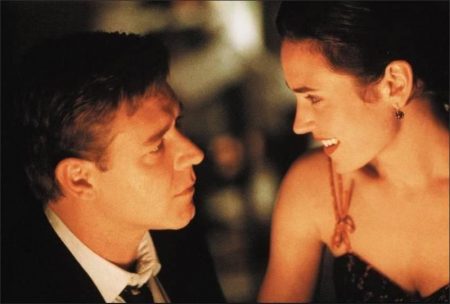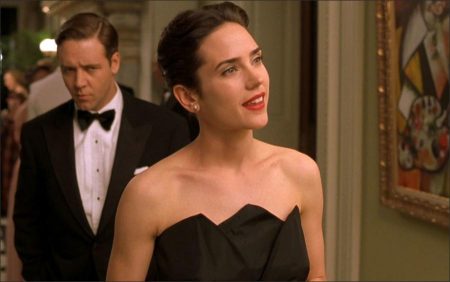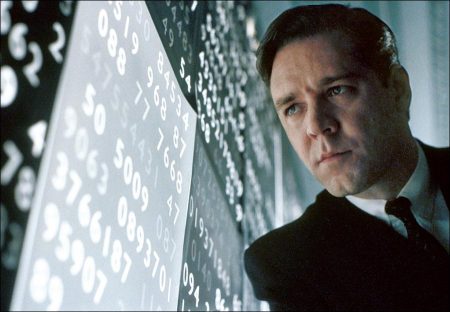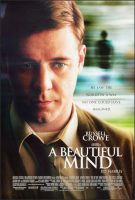In ”A Beautiful Mind,” her biography of the mathematician John Forbes Nash Jr., Sylvia Nasar quotes one of his colleagues: ”All mathematicians live in two different worlds. They live in a crystalline world of perfect platonic forms. An ice palace. But they also live in the common world where things are transient, ambiguous, subject to vicissitudes.” Mr. Nash, whose life is a case study in the difficulty — and also the wonder — of living in both, now inhabits a third: the treacle palace of middlebrow Hollywood moviemaking, in which ambiguity is dissolved in reassuring platitudes and freshly harvested tears.
The tears, and the dazzled glow that accompanies them, feel honestly earned. The paradox of Ron Howard’s new film, from a script by Akiva Goldsman, is that the story that elicits these genuine emotions is almost entirely counterfeit. At one point, Alicia Larde (Jennifer Connelly), the M.I.T. student who will marry Nash, breezes into his office, brandishing a proof she has devised for a fiendishly difficult hypothesis. Her professor and future husband looks up from the paper coffee cup he is chewing on and glances at her work. ”It’s elegant, but wrong,” he says, delivering a verdict that could just as well apply to ”A Beautiful Mind.”
Let’s work backward, from wrong to elegant. Mr. Nash, now 73, an inordinately gifted, deeply awkward man, possesses one of the most extraordinary mathematical intellects of his generation. By his early 30’s, when mental illness overwhelmed his creative powers, he had done important work in a number of fields, including game theory, quantum mechanics and number theory. After three decades of struggle with schizophrenia, he was granted what seemed like a miraculous remission. In 1994 he was awarded the Nobel Memorial Prize in economic science for work he had done as a graduate student at Princeton in the late 1940’s.
In outline then Mr. Nash’s life has the perfect three-act structure of a screenplay: a sparkling career derailed by adversity and redeemed by a triumph of the spirit. In detail the life, as recounted by Ms. Nasar, a former economics reporter for The New York Times, is a trove of fascinating, troubling information. In a profession whose members have a reputation for oddness, Mr. Nash was a prime number. He was notorious among his colleagues for his antisocial temperament and his predilection for cruel put-downs and dangerous practical jokes.
Before he married Alicia, with whom he had a son named John, he fathered another child, also named John, with a woman named Eleanor Stiers, and abandoned both mother and child to poverty. He formed a number of intense, apparently sexual bonds with other men, and he lost his security clearance and his position at the RAND Corporation after he was arrested for soliciting sex in a men’s room in Santa Monica, Calif. When his illness became intractable and his behavior intolerable, Alicia divorced him. (They remarried last June.)
None of this has made it to the screen. Worse, the intellectual and political context that would throw both Mr. Nash’s genius and his madness into high relief has been obliterated. ”A Beautiful Mind” opens with a speech by the fictitious Professor Helinger (Judd Hirsch), declaring that American mathematicians, having played an important part in the defeat of Nazi Germany, must now turn their attention to defeating Soviet Communism.
This scene, and much of the story that follows, egregiously simplifies the tangled, suspicious world of cold war academia. More than a few mathematicians and scientists at the time, including many at M.I.T., where Nash went to teach after Princeton (not, as the film has it, to conduct top-secret defense-related research), were sympathetic to Communism, and many more (including Robert Oppenheimer, whose name is mentioned in passing) were suspected of such sympathies.
While Mr. Nash was not among them, he was hardly the intrepid cold warrior depicted by Mr. Howard and Mr. Goldsman. Even at RAND, the Defense Department think tank, he was more interested in pure research than in its application, and in 1960 he tried to renounce his United States citizenship to express his belief in the necessity of world government.
All this, apparently, is too much for audiences to take in: anything that would dilute our sympathy by acquainting us with the vicissitudes of Mr. Nash’s real life has been airbrushed away, leaving a portrait of a shy, lovable genius. Of course any movie that traffics in biography must edit, foreshorten, emphasize and condense, but ”A Beautiful Mind” goes further, becoming a piece of historical revisionism on the order of ”J. F. K.” or ”Forrest Gump,” and manifesting a depressing lack of faith in the intelligence of the audience.
How much fidelity do movies owe to the historical figures they purport to be about? This question tends to interest the people who write about movies more than the people who make them. It does not, in any case, seem to have troubled Mr. Howard for a moment. But without stifling the objections noted above — and without giving credence to the trivializing, anti-intellectual rebuttal that it’s only a movie (only, as opposed to what?) — ”A Beautiful Mind” deserves to be judged on its own terms. Perhaps, adapting the conventions of mathematical notation, the movie character should be thought of as ”Nash prime” or Nashi (i referring to an imaginary number). The story of this Nash is not without its beauty.
There is, for one thing, Ms. Connelly, keen and spirited in the underwritten role of a woman who starts out as a math groupie and soon finds herself the helpmeet of a disturbed, difficult man. The rest of the supporting cast members — including Ed Harris as a government agent, Christopher Plummer as a sinister psychiatrist, Paul Bettany as an English dandy and Josh Lucas as a preening math jock — almost manage to keep their characters from becoming a parade of ciphers. Roger Deakins’s characteristically elegant cinematography turns the postwar Princeton campus into a honey-toned Arcadia.
But above all there is the fierce presence of Mr. Crowe, who refuses every temptation to overact the role set before him. Too often the chance to depict genius or mental disorder is taken, even by gifted actors like Dustin Hoffman (”Rain Man”) and Geoffrey Rush (”Shine”), as a license to show off.
Mr. Crowe, with his superhuman powers of concentration, shows us a man who dwells almost entirely in an inner world, and he dramatizes that inwardness as if nobody were watching. A faint smile plays across Nash’s mouth, and his speech is whispery and halting, with a suggestion of the South in its cadences. (Mr. Nash grew up in West Virginia.) As always with Mr. Crowe, you never feel that these are actorly mannerisms; they seem instead to arise from a deep absorption in the logic of the character.
In tackling the problem of how to bring us at least partway into Nash’s mind, Mr. Howard has come up with a clever conceit, as simple as it is inspired. Asked why he believed the wild delusions that characterized his illness, Mr. Nash replied that it was because they came to him ”the same way that my mathematical ideas did.” Rather than spoil the elaborate surprise Mr. Howard has concocted, I will note that he has found an accessible cinematic way to present this insight. (He also finds an entertaining way to convey the content of some of Mr. Nash’s mathematical insights; the theory that won him the Nobel is presented as a strategy for picking up women at a student bar.)
The hallucinations that increasingly plague Nash occupy the same reality as everything else. Schizophrenia does not announce itself as such to those it afflicts. Mr. Howard leads us into its infernal reality without posting a sign on the door, and the character’s way out of it seems at least metaphorically true to the real Mr. Nash’s account of his remission. ”I began to intellectually reject some of the delusionally influenced lines of thinking which had been characteristic of my orientation,” Mr. Nash wrote in a 1994 autobiographical essay.
Like his real-life counterpart, the movie Nash is impatient with detail-oriented hack work, preferring to search out ”governing dynamics.” The governing dynamic of ”A Beautiful Mind” is sentimentality of a familiar and not altogether unwelcome kind. The movie can — indeed, should — be intellectually rejected, but you can’t quite banish it from your mind.
A Beautiful Mind (2002)
Directed by: Ron Howard
Starring: Russell Crowe, Ed Harris, Jennifer Connelly, Christopher Plummer, Paul Bettany, Adam Goldberg, Victor Steinbach, Tanya Clarke, Vivien Cardone
Screenplay by: Sylvia Nasar, Akiva Goldsman
Cinematography by: Wynn Thomas
Costume Design by: Rita Ryack
Set Decoration by: Leslie E. Rollins
art Direction by: Robert Guerra
Makeup Department: Dale Brownell, Francesca Buccellato
Music by: James Horner
Distributed by Universal Pictures (North America), DreamWorks Pictures (International)
Release Date: January 4, 2002
Visits: 247







